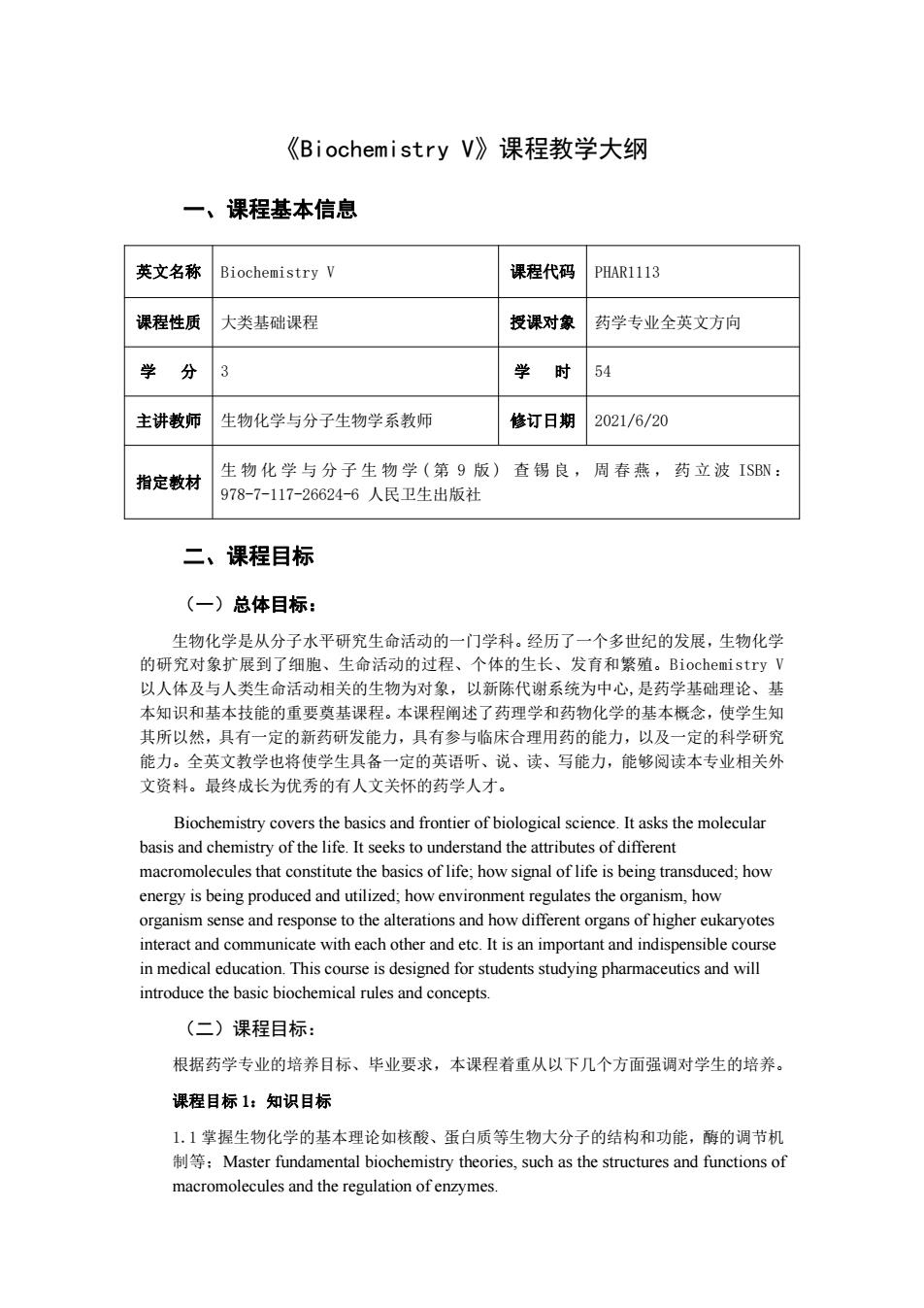
《Biochemistry V》课程教学大纲 一、课程基本信息 英文名称 Biochemistry V 课程代码 PHAR1113 课程性质 大类基础课程 授课对象 药学专业全英文方向 学 分 3 学 时 54 主讲教师 生物化学与分子生物学系教师 修订日期 2021/6/20 生物化学与分子生物学(第9版)查锡良,周春燕,药立波ISBN: 指定教材 978-7-117-26624-6人民卫生出版社 二、课程目标 (一)总体目标: 生物化学是从分子水平研究生命活动的一门学科。经历了一个多世纪的发展,生物化学 的研究对象扩展到了细胞、生命活动的过程、个体的生长、发育和繁殖。Biochemistry V 以人体及与人类生命活动相关的生物为对象,以新陈代谢系统为中心,是药学基础理论、基 本知识和基本技能的重要奠基课程。本课程阐述了药理学和药物化学的基本概念,使学生知 其所以然,具有一定的新药研发能力,具有参与临床合理用药的能力,以及一定的科学研究 能力。全英文教学也将使学生具备一定的英语听、说、读、写能力,能够阅读本专业相关外 文资料。最终成长为优秀的有人文关怀的药学人才。 Biochemistry covers the basics and frontier of biological science.It asks the molecular basis and chemistry of the life.It seeks to understand the attributes of different macromolecules that constitute the basics of life;how signal of life is being transduced;how energy is being produced and utilized;how environment regulates the organism,how organism sense and response to the alterations and how different organs of higher eukaryotes interact and communicate with each other and etc.It is an important and indispensible course in medical education.This course is designed for students studying pharmaceutics and will introduce the basic biochemical rules and concepts. (二)课程目标: 根据药学专业的培养目标、毕业要求,本课程着重从以下几个方面强调对学生的培养。 课程目标1:知识目标 1.1掌握生物化学的基本理论如核酸、蛋白质等生物大分子的结构和功能,酶的调节机 Master fundamental biochemistry theories,such as the structures and functions of macromolecules and the regulation of enzymes
《Biochemistry V》课程教学大纲 一、课程基本信息 英文名称 Biochemistry V 课程代码 PHAR1113 课程性质 大类基础课程 授课对象 药学专业全英文方向 学 分 3 学 时 54 主讲教师 生物化学与分子生物学系教师 修订日期 2021/6/20 指定教材 生 物 化 学 与 分 子 生 物 学 ( 第 9 版 ) 查 锡 良 , 周 春 燕 , 药 立 波 ISBN : 978-7-117-26624-6 人民卫生出版社 二、课程目标 (一)总体目标: 生物化学是从分子水平研究生命活动的一门学科。经历了一个多世纪的发展,生物化学 的研究对象扩展到了细胞、生命活动的过程、个体的生长、发育和繁殖。Biochemistry V 以人体及与人类生命活动相关的生物为对象,以新陈代谢系统为中心,是药学基础理论、基 本知识和基本技能的重要奠基课程。本课程阐述了药理学和药物化学的基本概念,使学生知 其所以然,具有一定的新药研发能力,具有参与临床合理用药的能力,以及一定的科学研究 能力。全英文教学也将使学生具备一定的英语听、说、读、写能力,能够阅读本专业相关外 文资料。最终成长为优秀的有人文关怀的药学人才。 Biochemistry covers the basics and frontier of biological science. It asks the molecular basis and chemistry of the life. It seeks to understand the attributes of different macromolecules that constitute the basics of life; how signal of life is being transduced; how energy is being produced and utilized; how environment regulates the organism, how organism sense and response to the alterations and how different organs of higher eukaryotes interact and communicate with each other and etc. It is an important and indispensible course in medical education. This course is designed for students studying pharmaceutics and will introduce the basic biochemical rules and concepts. (二)课程目标: 根据药学专业的培养目标、毕业要求,本课程着重从以下几个方面强调对学生的培养。 课程目标 1:知识目标 1.1 掌握生物化学的基本理论如核酸、蛋白质等生物大分子的结构和功能,酶的调节机 制等;Master fundamental biochemistry theories, such as the structures and functions of macromolecules and the regulation of enzymes
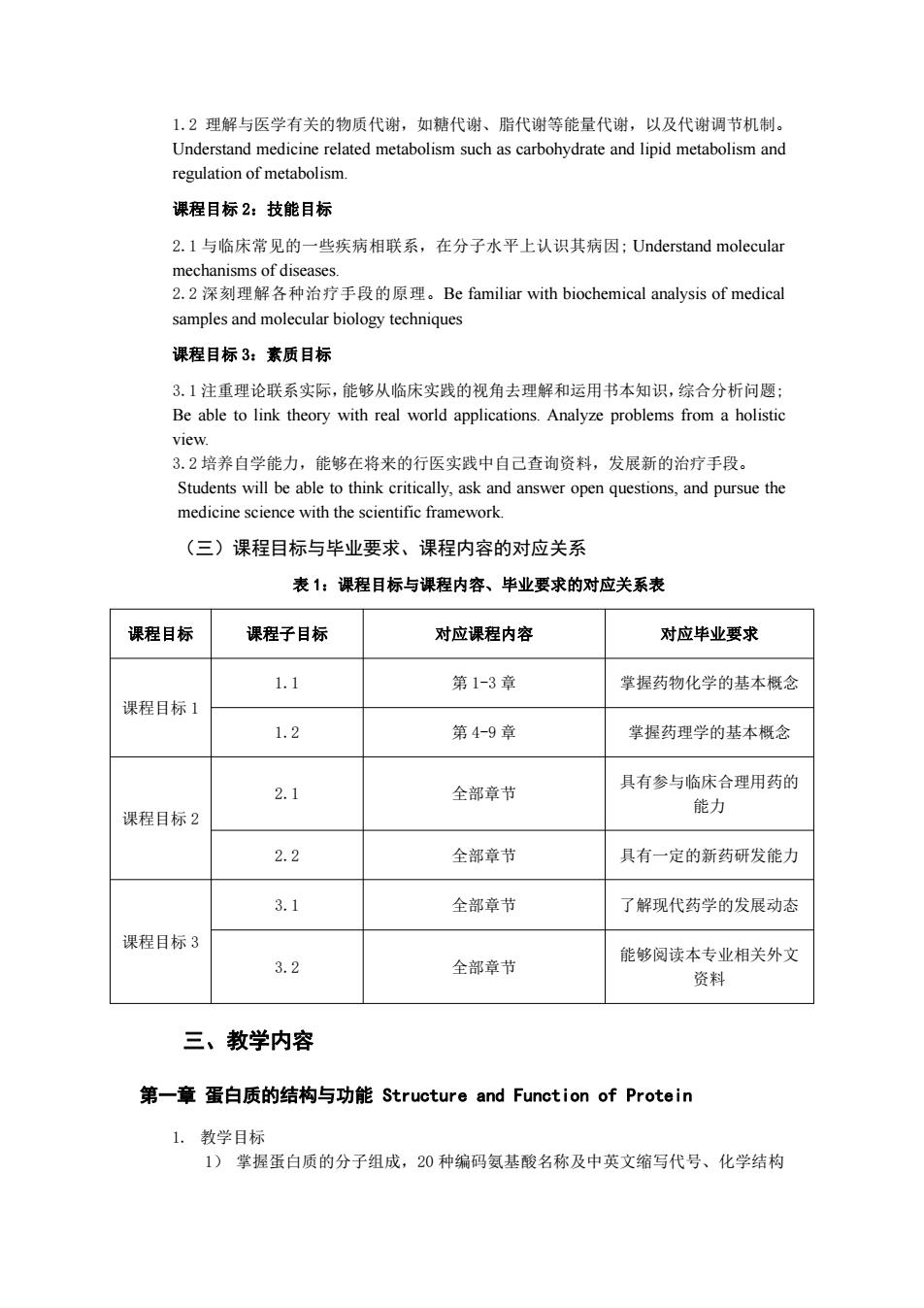
1.2理解与医学有关的物质代谢,如糖代谢、脂代谢等能量代谢,以及代谢调节机制。 Understand medicine related metabolism such as carbohydrate and lipid metabolism and regulation of metabolism. 课程目标2:技能目标 2.1与临床常见的一些疾病相联系,在分子水平上认识其病因:Understand molecular mechanisms of diseases. 2.2深刻理解各种治疗手段的原理。Be familiar with biochemical analysis of medical samples and molecular biology techniques 课程目标3:素质目标 3.1注重理论联系实际,能够从临床实践的视角去理解和运用书本知识,综合分析问题: Be able to link theory with real world applications.Analyze problems from a holistic view. 3.2培养自学能力,能够在将来的行医实践中自己查询资料,发展新的治疗手段。 Students will be able to think critically,ask and answer open questions,and pursue the medicine science with the scientific framework. (三)课程目标与毕业要求、课程内容的对应关系 表1:课程目标与课程内容、毕业要求的对应关系表 课程目标 课程子目标 对应课程内容 对应毕业要求 1.1 第1-3章 掌握药物化学的基本概念 课程目标1 1.2 第4-9章 掌握药理学的基本概念 2.1 全部章节 具有参与临床合理用药的 能力 课程目标2 2.2 全部章节 具有一定的新药研发能力 3.1 全部章节 了解现代药学的发展动态 课程目标3 能够阅读本专业相关外文 3.2 全部章节 资料 三、教学内容 第一章蛋白质的结构与功能Structure and Function of Protein 1.教学目标 1)掌握蛋白质的分子组成,20种编码氨基酸名称及中英文缩写代号、化学结构
1.2 理解与医学有关的物质代谢,如糖代谢、脂代谢等能量代谢,以及代谢调节机制。 Understand medicine related metabolism such as carbohydrate and lipid metabolism and regulation of metabolism. 课程目标 2:技能目标 2.1 与临床常见的一些疾病相联系,在分子水平上认识其病因; Understand molecular mechanisms of diseases. 2.2 深刻理解各种治疗手段的原理。Be familiar with biochemical analysis of medical samples and molecular biology techniques 课程目标 3:素质目标 3.1 注重理论联系实际,能够从临床实践的视角去理解和运用书本知识,综合分析问题; Be able to link theory with real world applications. Analyze problems from a holistic view. 3.2 培养自学能力,能够在将来的行医实践中自己查询资料,发展新的治疗手段。 Students will be able to think critically, ask and answer open questions, and pursue the medicine science with the scientific framework. (三)课程目标与毕业要求、课程内容的对应关系 表 1:课程目标与课程内容、毕业要求的对应关系表 课程目标 课程子目标 对应课程内容 对应毕业要求 课程目标 1 1.1 第 1-3 章 掌握药物化学的基本概念 1.2 第 4-9 章 掌握药理学的基本概念 课程目标 2 2.1 全部章节 具有参与临床合理用药的 能力 2.2 全部章节 具有一定的新药研发能力 课程目标 3 3.1 全部章节 了解现代药学的发展动态 3.2 全部章节 能够阅读本专业相关外文 资料 三、教学内容 第一章 蛋白质的结构与功能 Structure and Function of Protein 1. 教学目标 1) 掌握蛋白质的分子组成,20 种编码氨基酸名称及中英文缩写代号、化学结构
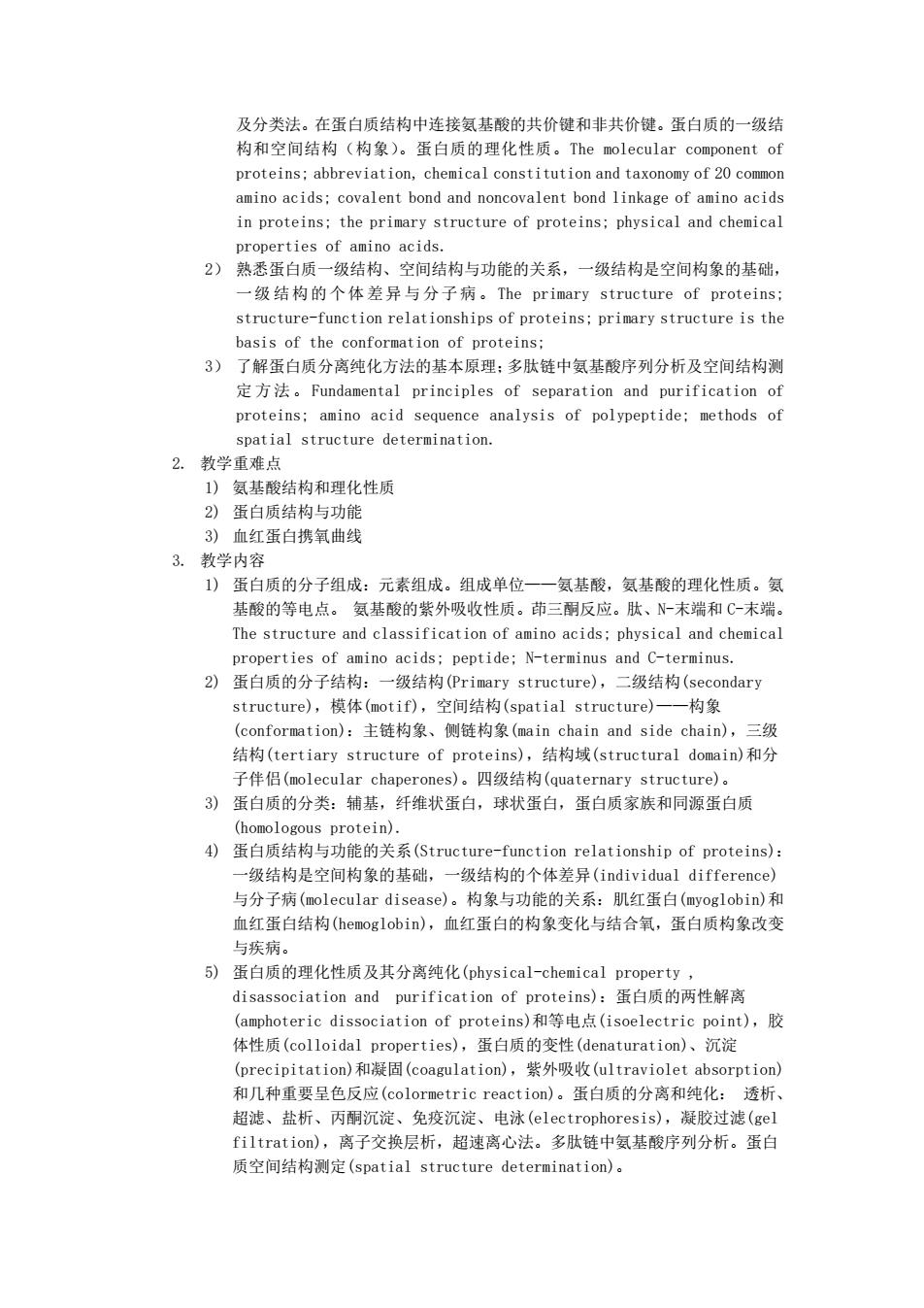
及分类法。在蛋白质结构中连接氨基酸的共价键和非共价键。蛋白质的一级结 构和空间结构(构象)。蛋白质的理化性质。The molecular component of proteins;abbreviation,chemical constitution and taxonomy of 20 common amino acids;covalent bond and noncovalent bond linkage of amino acids in proteins;the primary structure of proteins;physical and chemical properties of amino acids. 2)熟悉蛋白质一级结构、空间结构与功能的关系,一级结构是空间构象的基础, 一 级结构的个体差异与分子病。The primary structure of proteins; structure-function relationships of proteins;primary structure is the basis of the conformation of proteins; 3)了解蛋白质分离纯化方法的基本原理:多肽链中氨基酸序列分析及空间结构测 定方法。Fundamental principles of separation and purification of proteins;amino acid sequence analysis of polypeptide;methods of spatial structure determination. 2.教学重难点 1)氨基酸结构和理化性质 2)蛋白质结构与功能 3)血红蛋白携氧曲线 3.教学内容 1)蛋白质的分子组成:元素组成。组成单位一一氨基酸,氨基酸的理化性质。氨 基酸的等电点。氨基酸的紫外吸收性质。茚三酮反应。肽、N-末端和C-末端。 The structure and classification of amino acids;physical and chemical properties of amino acids;peptide;N-terminus and C-terminus. 2)蛋白质的分子结构:一级结构(Primary structure),二级结构(secondary structure),模体(motif),空间结构(spatial structure)一一构象 (conformation):主链构象、侧链构象(main chain and side chain),三级 结构(tertiary structure of proteins),结构域(structural domain)和分 子伴侣(molecular chaperones)。四级结构(quaternary structure)。 3)蛋白质的分类:辅基,纤维状蛋白,球状蛋白,蛋白质家族和同源蛋白质 (homologous protein). 4)蛋白质结构与功能的关系(Structure-function relationship of proteins): 一级结构是空间构象的基础,一级结构的个体差异(individual difference) 与分子病(molecular disease)。构象与功能的关系:肌红蛋白(myoglobin)和 血红蛋白结构(hemoglobin),血红蛋白的构象变化与结合氧,蛋白质构象改变 与疾病。 5)蛋白质的理化性质及其分离纯化(physical-chemical property, disassociation and purification of proteins):蛋白质的两性解离 (amphoteric dissociation of proteins)和等电点(isoelectric point),胶 体性质(colloidal properties).,蛋白质的变性(denaturation)、沉淀 (precipitation)和凝固(coagulation),紫外吸收(ultraviolet absorption) 和几种重要呈色反应(colormetric reaction)。蛋白质的分离和纯化:透析、 超滤、盐析、丙酮沉淀、免疫沉淀、电泳(electrophoresis),凝胶过滤(gel filtration),离子交换层析,超速离心法。多肽链中氨基酸序列分析。蛋白 质空间结构测定(spatial structure determination)
及分类法。在蛋白质结构中连接氨基酸的共价键和非共价键。蛋白质的一级结 构和空间结构(构象)。蛋白质的理化性质。The molecular component of proteins; abbreviation, chemical constitution and taxonomy of 20 common amino acids; covalent bond and noncovalent bond linkage of amino acids in proteins; the primary structure of proteins; physical and chemical properties of amino acids. 2) 熟悉蛋白质一级结构、空间结构与功能的关系,一级结构是空间构象的基础, 一级结构的个体差异与分子病。The primary structure of proteins; structure-function relationships of proteins; primary structure is the basis of the conformation of proteins; 3) 了解蛋白质分离纯化方法的基本原理;多肽链中氨基酸序列分析及空间结构测 定 方 法 。Fundamental principles of separation and purification of proteins; amino acid sequence analysis of polypeptide; methods of spatial structure determination. 2. 教学重难点 1) 氨基酸结构和理化性质 2) 蛋白质结构与功能 3) 血红蛋白携氧曲线 3. 教学内容 1) 蛋白质的分子组成:元素组成。组成单位——氨基酸,氨基酸的理化性质。氨 基酸的等电点。 氨基酸的紫外吸收性质。茚三酮反应。肽、N-末端和 C-末端。 The structure and classification of amino acids; physical and chemical properties of amino acids; peptide; N-terminus and C-terminus. 2) 蛋白质的分子结构:一级结构(Primary structure),二级结构(secondary structure),模体(motif),空间结构(spatial structure)——构象 (conformation):主链构象、侧链构象(main chain and side chain),三级 结构(tertiary structure of proteins),结构域(structural domain)和分 子伴侣(molecular chaperones)。四级结构(quaternary structure)。 3) 蛋白质的分类:辅基,纤维状蛋白,球状蛋白,蛋白质家族和同源蛋白质 (homologous protein). 4) 蛋白质结构与功能的关系(Structure-function relationship of proteins): 一级结构是空间构象的基础,一级结构的个体差异(individual difference) 与分子病(molecular disease)。构象与功能的关系:肌红蛋白(myoglobin)和 血红蛋白结构(hemoglobin),血红蛋白的构象变化与结合氧,蛋白质构象改变 与疾病。 5) 蛋白质的理化性质及其分离纯化(physical-chemical property , disassociation and purification of proteins):蛋白质的两性解离 (amphoteric dissociation of proteins)和等电点(isoelectric point),胶 体性质(colloidal properties),蛋白质的变性(denaturation)、沉淀 (precipitation)和凝固(coagulation),紫外吸收(ultraviolet absorption) 和几种重要呈色反应(colormetric reaction)。蛋白质的分离和纯化: 透析、 超滤、盐析、丙酮沉淀、免疫沉淀、电泳(electrophoresis),凝胶过滤(gel filtration),离子交换层析,超速离心法。多肽链中氨基酸序列分析。蛋白 质空间结构测定(spatial structure determination)
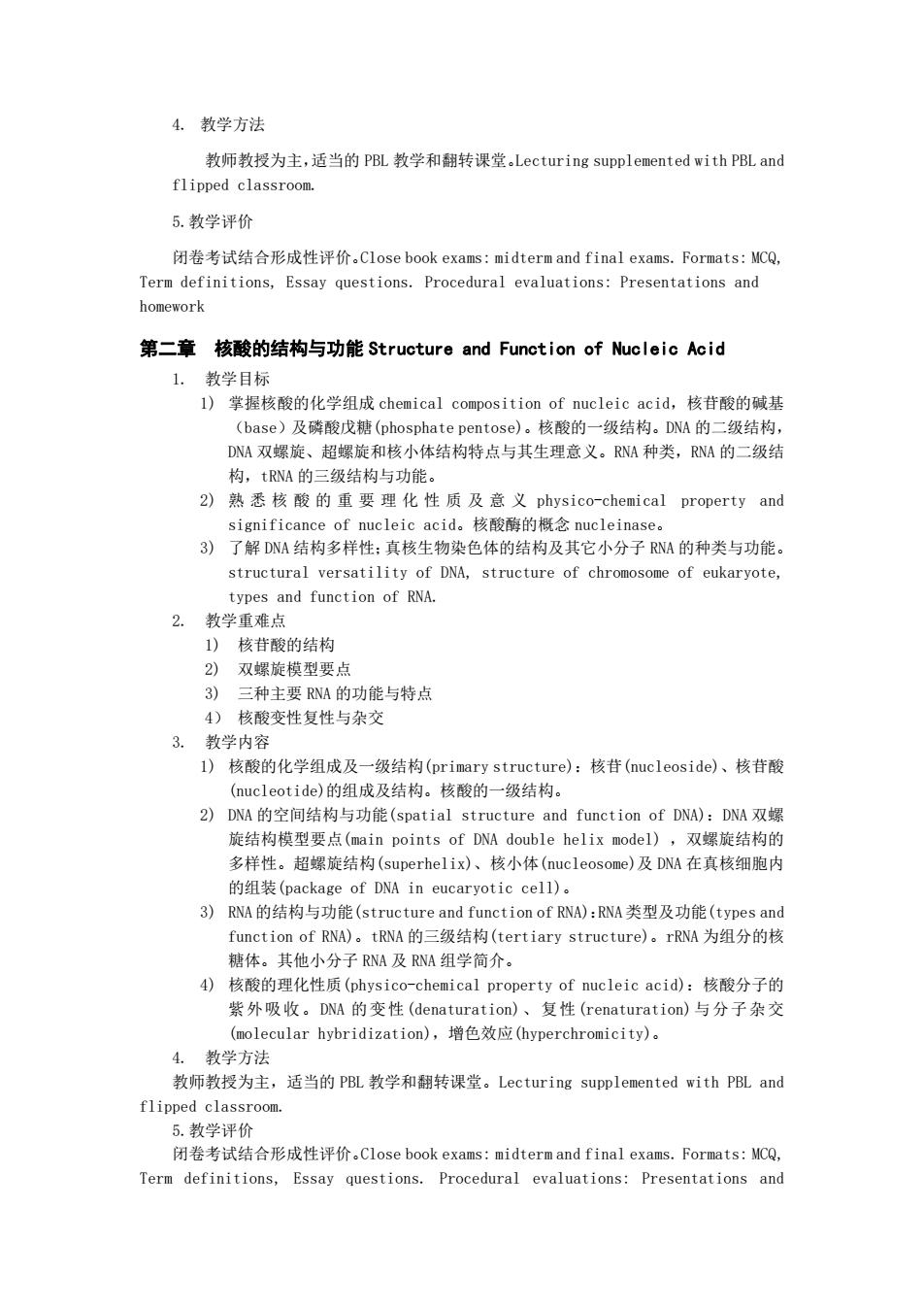
4.教学方法 教师教授为主,适当的PBL教学和翻转课堂.Lecturing supplemented with PBL and flipped classroom. 5.教学评价 闭卷考试结合形成性评价.Close book exams:midterm and final exams..Formats:MCQ, Term definitions,Essay questions.Procedural evaluations:Presentations and homework 第二章核酸的结构与功能Structure and Function of Nucleic Acid 1.教学目标 l)掌握核酸的化学组成chemical composition of nucleic acid,核苷酸的碱基 (base)及磷酸戊糖(phosphate pentose)。核酸的一级结构。DNA的二级结构, DNA双螺旋、超螺旋和核小体结构特点与其生理意义。RNA种类,RNA的二级结 构,tRNA的三级结构与功能。 2)熟悉核酸的重要理化性质及意义physico-chemical property and significance of nucleic acid.。核酸酶的概念nucleinase.。 3)了解DNA结构多样性:真核生物染色体的结构及其它小分子RNA的种类与功能。 structural versatility of DNA,structure of chromosome of eukaryote, types and function of RNA. 2.教学重难点 1)核苷酸的结构 2)双螺旋模型要点 3)三种主要RNA的功能与特点 4)核酸变性复性与杂交 3.教学内容 1)核酸的化学组成及一级结构(primary structure):核苷(nucleoside)、核苷酸 (nucleotide)的组成及结构。核酸的一级结构。 2)DNA的空间结构与功能(spatial structure and function of DNA):DNA双螺 旋结构模型要点(main points of DNA double helix model),双螺旋结构的 多样性。超螺旋结构(superhelix)、核小体(nucleosome).及DNA在真核细胞内 的组装(package of DNA in eucaryotic cell)。 3)RNA的结构与功能(structure and function of RNA):RNA类型及功能(types and function of RNA)。tRNA的三级结构(tertiary structure)。rRNA为组分的核 糖体。其他小分子RNA及RNA组学简介。 4)核酸的理化性质(physico--chemical property of nucleic acid),:核酸分子的 紫外吸收。DNA的变性(denaturation)、复性(renaturation)与分子杂交 (molecular hybridization),,增色效应(hyperchromicity)。 4.教学方法 教师教授为主,适当的PBL教学和翻转课堂。Lecturing supplemented with PBL and flipped classroom. 5.教学评价 闭卷考试结合形成性评价.Close book exams:midterm and final exams..Formats:MCQ, Term definitions,Essay questions.Procedural evaluations:Presentations and
4. 教学方法 教师教授为主,适当的 PBL 教学和翻转课堂。Lecturing supplemented with PBL and flipped classroom. 5.教学评价 闭卷考试结合形成性评价。Close book exams: midterm and final exams. Formats: MCQ, Term definitions, Essay questions. Procedural evaluations: Presentations and homework 第二章 核酸的结构与功能 Structure and Function of Nucleic Acid 1. 教学目标 1) 掌握核酸的化学组成 chemical composition of nucleic acid,核苷酸的碱基 (base)及磷酸戊糖(phosphate pentose)。核酸的一级结构。DNA 的二级结构, DNA 双螺旋、超螺旋和核小体结构特点与其生理意义。RNA 种类,RNA 的二级结 构,tRNA 的三级结构与功能。 2) 熟 悉 核 酸 的 重 要 理 化 性 质 及 意 义 physico-chemical property and significance of nucleic acid。核酸酶的概念 nucleinase。 3) 了解 DNA 结构多样性;真核生物染色体的结构及其它小分子 RNA 的种类与功能。 structural versatility of DNA, structure of chromosome of eukaryote, types and function of RNA. 2. 教学重难点 1) 核苷酸的结构 2) 双螺旋模型要点 3) 三种主要 RNA 的功能与特点 4) 核酸变性复性与杂交 3. 教学内容 1) 核酸的化学组成及一级结构(primary structure):核苷(nucleoside)、核苷酸 (nucleotide)的组成及结构。核酸的一级结构。 2) DNA 的空间结构与功能(spatial structure and function of DNA):DNA 双螺 旋结构模型要点(main points of DNA double helix model) ,双螺旋结构的 多样性。超螺旋结构(superhelix)、核小体(nucleosome)及 DNA 在真核细胞内 的组装(package of DNA in eucaryotic cell)。 3) RNA 的结构与功能(structure and function of RNA):RNA 类型及功能(types and function of RNA)。tRNA 的三级结构(tertiary structure)。rRNA 为组分的核 糖体。其他小分子 RNA 及 RNA 组学简介。 4) 核酸的理化性质(physico-chemical property of nucleic acid):核酸分子的 紫外吸收。DNA 的变性(denaturation)、复性(renaturation)与分子杂交 (molecular hybridization),增色效应(hyperchromicity)。 4. 教学方法 教师教授为主,适当的 PBL 教学和翻转课堂。Lecturing supplemented with PBL and flipped classroom. 5.教学评价 闭卷考试结合形成性评价。Close book exams: midterm and final exams. Formats: MCQ, Term definitions, Essay questions. Procedural evaluations: Presentations and
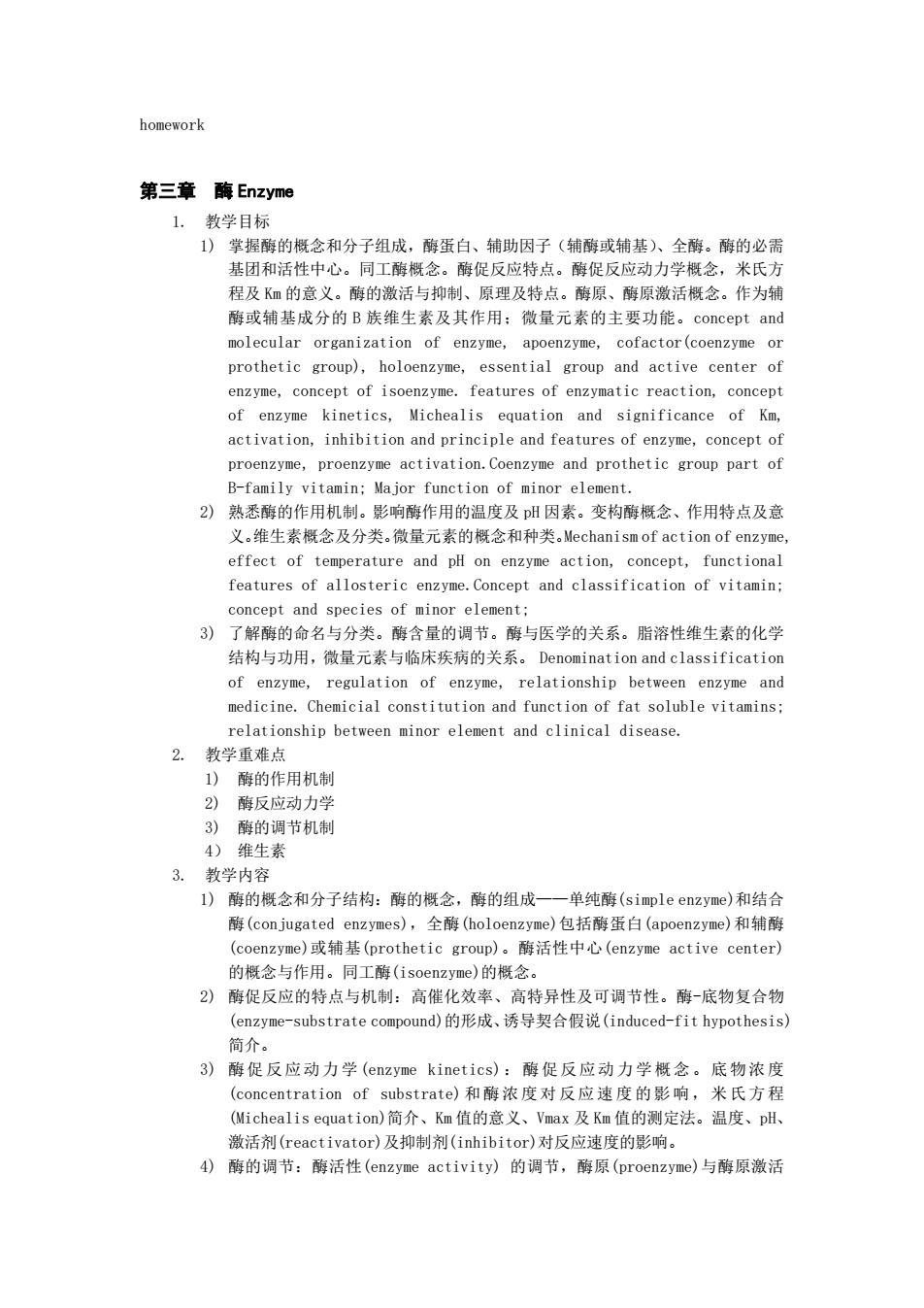
homework 第三章酶Enzyme 1.教学目标 1)掌握酶的概念和分子组成,酶蛋白、辅助因子(辅酶或辅基)、全酶。酶的必需 基团和活性中心。同工酶概念。酶促反应特点。酶促反应动力学概念,米氏方 程及K的意义。酶的激活与抑制、原理及特点。酶原、酶原激活概念。作为辅 酶或辅基成分的B族维生素及其作用:微量元素的主要功能。concept and molecular organization of enzyme,apoenzyme,cofactor(coenzyme or prothetic group),holoenzyme,essential group and active center of enzyme,concept of isoenzyme.features of enzymatic reaction,concept of enzyme kinetics,Michealis equation and significance of Km, activation,inhibition and principle and features of enzyme,concept of proenzyme,proenzyme activation.Coenzyme and prothetic group part of B-family vitamin;Major function of minor element. 2)熟悉酶的作用机制。影响酶作用的温度及pH因素。变构酶概念、作用特点及意 义。维生素概念及分类。微量元素的概念和种类.Mechanism of action of enzyme, effect of temperature and pH on enzyme action,concept,functional features of allosteric enzyme.Concept and classification of vitamin; concept and species of minor element; 3)了解酶的命名与分类。酶含量的调节。酶与医学的关系。脂溶性维生素的化学 结构与功用,微量元素与临床疾病的关系。Denomination and classification of enzyme,regulation of enzyme,relationship between enzyme and medicine.Chemicial constitution and function of fat soluble vitamins: relationship between minor element and clinical disease. 2.教学重难点 1)酶的作用机制 2)酶反应动力学 3)酶的调节机制 4)维生素 3.教学内容 l)酶的概念和分子结构:酶的概念,酶的组成一一单纯酶(simple enzyme)和结合 酶(conjugated enzymes).,全酶(holoenzyme)包括酶蛋白(apoenzyme)和辅酶 (coenzyme)或辅基(prothetic group)。酶活性中心(enzyme active center). 的概念与作用。同工酶(isoenzyme)的概念。 2)酶促反应的特点与机制:高催化效率、高特异性及可调节性。酶-底物复合物 (enzyme-substrate compound)的形成、诱导契合假说(induced-fit hypothesis). 简介。 3)酶促反应动力学(enzyme kinetics):酶促反应动力学概念。底物浓度 (concentration of substrate)和酶浓度对反应速度的影响,米氏方程 (Michealis equation)简介、Km值的意义、Vmax及Km值的测定法。温度、pH、 激活剂(reactivator)及抑制剂(inhibitor)对反应速度的影响。 4)酶的调节:酶活性(enzyme activity)的调节,酶原(proenzyme)与酶原激活
homework 第三章 酶 Enzyme 1. 教学目标 1) 掌握酶的概念和分子组成,酶蛋白、辅助因子(辅酶或辅基)、全酶。酶的必需 基团和活性中心。同工酶概念。酶促反应特点。酶促反应动力学概念,米氏方 程及 Km 的意义。酶的激活与抑制、原理及特点。酶原、酶原激活概念。作为辅 酶或辅基成分的 B 族维生素及其作用;微量元素的主要功能。concept and molecular organization of enzyme, apoenzyme, cofactor(coenzyme or prothetic group), holoenzyme, essential group and active center of enzyme, concept of isoenzyme. features of enzymatic reaction, concept of enzyme kinetics, Michealis equation and significance of Km, activation, inhibition and principle and features of enzyme, concept of proenzyme, proenzyme activation.Coenzyme and prothetic group part of B-family vitamin; Major function of minor element. 2) 熟悉酶的作用机制。影响酶作用的温度及 pH 因素。变构酶概念、作用特点及意 义。维生素概念及分类。微量元素的概念和种类。Mechanism of action of enzyme, effect of temperature and pH on enzyme action, concept, functional features of allosteric enzyme.Concept and classification of vitamin; concept and species of minor element; 3) 了解酶的命名与分类。酶含量的调节。酶与医学的关系。脂溶性维生素的化学 结构与功用,微量元素与临床疾病的关系。 Denomination and classification of enzyme, regulation of enzyme, relationship between enzyme and medicine. Chemicial constitution and function of fat soluble vitamins; relationship between minor element and clinical disease. 2. 教学重难点 1) 酶的作用机制 2) 酶反应动力学 3) 酶的调节机制 4) 维生素 3. 教学内容 1) 酶的概念和分子结构:酶的概念,酶的组成——单纯酶(simple enzyme)和结合 酶(conjugated enzymes),全酶(holoenzyme)包括酶蛋白(apoenzyme)和辅酶 (coenzyme)或辅基(prothetic group)。酶活性中心(enzyme active center) 的概念与作用。同工酶(isoenzyme)的概念。 2) 酶促反应的特点与机制:高催化效率、高特异性及可调节性。酶-底物复合物 (enzyme-substrate compound)的形成、诱导契合假说(induced-fit hypothesis) 简介。 3) 酶促 反应动力 学(enzyme kinetics):酶 促反应动 力学概念 。底物浓 度 (concentration of substrate)和 酶 浓 度对 反 应 速 度 的 影 响, 米 氏 方 程 (Michealis equation)简介、Km 值的意义、Vmax 及 Km 值的测定法。温度、pH、 激活剂(reactivator)及抑制剂(inhibitor)对反应速度的影响。 4) 酶的调节:酶活性(enzyme activity) 的调节,酶原(proenzyme)与酶原激活
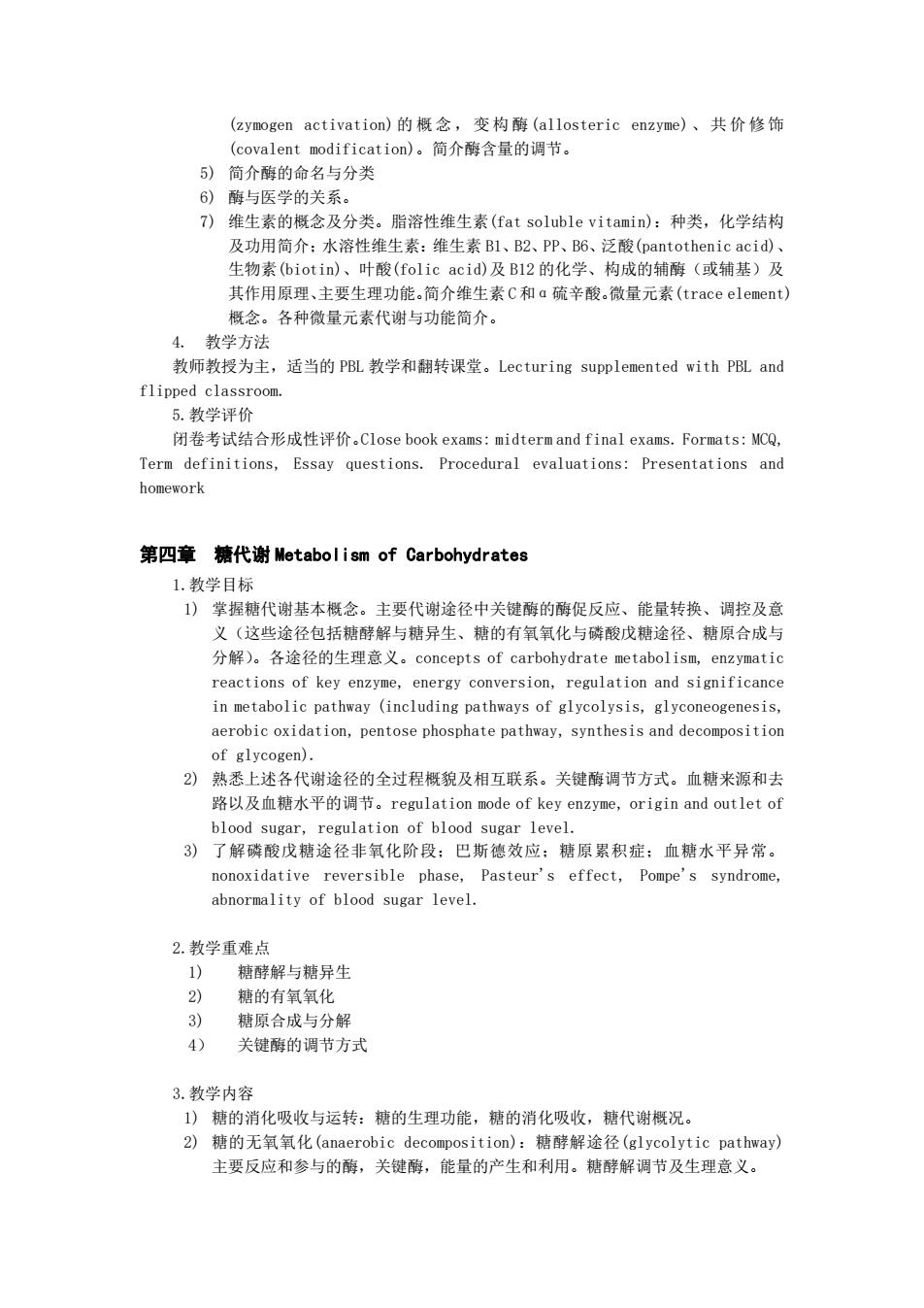
(zymogen activation)的概念,变构酶(allosteric enzyme)、共价修饰 (covalent modification)。简介酶含量的调节。 5)简介酶的命名与分类 6)酶与医学的关系。 7)维生素的概念及分类。脂溶性维生素(fat soluble vitamin):种类,化学结构 及功用简介:水溶性维生素:维生素Bl、B2、PP、B6、泛酸(pantothenic acid)、 生物素(biotin)、叶酸(folic acid)及Bl2的化学、构成的辅酶(或辅基)及 其作用原理、主要生理功能.简介维生素C和a硫辛酸。微量元素(trace element)) 概念。各种微量元素代谢与功能简介。 4.教学方法 教师教授为主,适当的PBL教学和翻转课堂。Lecturing supplemented with PBL and flipped classroom. 5.教学评价 闭卷考试结合形成性评价.Close book exams:midterm and final exams..Formats:MCQ, Term definitions,Essay questions.Procedural evaluations:Presentations and homework 第四章糖代谢Metabol ism of Carbohydrates 1.教学目标 1)掌握糖代谢基本概念。主要代谢途径中关键酶的酶促反应、能量转换、调控及意 义(这些途径包括糖酵解与糖异生、糖的有氧氧化与磷酸戊糖途径、糖原合成与 分解)。各途径的生理意义。concepts of carbohydrate metabolism,enzymatic reactions of key enzyme,energy conversion,regulation and significance in metabolic pathway (including pathways of glycolysis,glyconeogenesis, aerobic oxidation,pentose phosphate pathway,synthesis and decomposition of glycogen). 2)熟悉上述各代谢途径的全过程概貌及相互联系。关键酶调节方式。血糖来源和去 路以及血糖水平的调节。regulation mode of key enzyme,origin and outlet of blood sugar,regulation of blood sugar level. 3)了解磷酸戊糖途径非氧化阶段:巴斯德效应:糖原累积症:血糖水平异常。 nonoxidative reversible phase,Pasteur's effect,Pompe's syndrome, abnormality of blood sugar level. 2.教学重难点 1)糖酵解与糖异生 2) 糖的有氧氧化 3) 糖原合成与分解 4) 关键酶的调节方式 3.教学内容 1)糖的消化吸收与运转:糖的生理功能,糖的消化吸收,糖代谢概况。 2)糖的无氧氧化(anaerobic decomposition),:糖酵解途径(glycolytic pathway) 主要反应和参与的酶,关键酶,能量的产生和利用。糖酵解调节及生理意义
(zymogen activation) 的 概 念 , 变 构 酶 (allosteric enzyme) 、 共 价 修 饰 (covalent modification)。简介酶含量的调节。 5) 简介酶的命名与分类 6) 酶与医学的关系。 7) 维生素的概念及分类。脂溶性维生素(fat soluble vitamin):种类,化学结构 及功用简介;水溶性维生素:维生素 B1、B2、PP、B6、泛酸(pantothenic acid)、 生物素(biotin)、叶酸(folic acid)及 B12 的化学、构成的辅酶(或辅基)及 其作用原理、主要生理功能。简介维生素 C 和α硫辛酸。微量元素(trace element) 概念。各种微量元素代谢与功能简介。 4. 教学方法 教师教授为主,适当的 PBL 教学和翻转课堂。Lecturing supplemented with PBL and flipped classroom. 5.教学评价 闭卷考试结合形成性评价。Close book exams: midterm and final exams. Formats: MCQ, Term definitions, Essay questions. Procedural evaluations: Presentations and homework 第四章 糖代谢 Metabolism of Carbohydrates 1.教学目标 1) 掌握糖代谢基本概念。主要代谢途径中关键酶的酶促反应、能量转换、调控及意 义(这些途径包括糖酵解与糖异生、糖的有氧氧化与磷酸戊糖途径、糖原合成与 分解)。各途径的生理意义。concepts of carbohydrate metabolism, enzymatic reactions of key enzyme, energy conversion, regulation and significance in metabolic pathway (including pathways of glycolysis, glyconeogenesis, aerobic oxidation, pentose phosphate pathway, synthesis and decomposition of glycogen). 2) 熟悉上述各代谢途径的全过程概貌及相互联系。关键酶调节方式。血糖来源和去 路以及血糖水平的调节。regulation mode of key enzyme, origin and outlet of blood sugar, regulation of blood sugar level. 3) 了解磷酸戊糖途径非氧化阶段;巴斯德效应;糖原累积症;血糖水平异常。 nonoxidative reversible phase, Pasteur's effect, Pompe's syndrome, abnormality of blood sugar level. 2.教学重难点 1) 糖酵解与糖异生 2) 糖的有氧氧化 3) 糖原合成与分解 4) 关键酶的调节方式 3.教学内容 1) 糖的消化吸收与运转:糖的生理功能,糖的消化吸收,糖代谢概况。 2) 糖的无氧氧化(anaerobic decomposition):糖酵解途径(glycolytic pathway) 主要反应和参与的酶,关键酶,能量的产生和利用。糖酵解调节及生理意义

3)糖的有氧氧化(aerobic oxidation):反应过程包括细胞反应阶段、丙酮酸在线粒 体内生成乙酰CoA(acetyl CoA)、三羧酸循环(TCA cycle)。三羧酸循环的过程和 关键酶。糖有氧氧化的产能和调节概述,生理意义。简介巴斯德效应(Pasteur's effect)。 4)磷酸戊糖途径(pentose phosphate pathway):氧化反应阶段(oxidizing reaction)、NADPH及磷酸戊糖(pentose)的产生,非氧化反应阶段概述。调节及 生理意义。 5)糖原的合成与分解(synthesis and decompose of glycogen):糖原合成与分解途 径的酶促反应、UDPG生成、糖原合成酶(glycogen synthase)、磷酸化酶 (phosphorylase)。糖原合成与分解的调节及意义。 6)糖异生(glyconeogenesis):反应过程及关键酶,能量消耗,调节及生理意义,乳 酸循环(Cori cycle)。 7)葡萄糖的其他代谢产物:糖醛酸途径,多元醇途径及血红蛋白运氧的调节。 8)血糖及其调节:血糖的来源和去路,血糖水平的肝脏调节及激素调节,简介血糖 水平异常,高糖刺激。 4.教学方法 教师教授为主,适当的PBL教学和翻转课堂。Lecturing supplemented with PBL and flipped classroom. 5.教学评价 闭卷考试结合形成性评价。Close book exams:midterm and final exams.Formats:MCQ, Term definitions,Essay questions.Procedural evaluations:Presentations and homework 第五章脂质代谢Metabolism of Lipids 1.教学目标 1)掌握脂质的概念和分类。脂肪动员和激素敏感甘油三酯脂肪酶。脂酸B-氧化的 反应过程。酮体的概念、组成、代谢特点、氧化利用及生理意义。磷脂的种类。 胆固醇的结构特点,胆固醇合成关键酶及重要反应步骤,胆固醇的转化及转化 产物的生理功能。血浆脂蛋白的概念、分类、结构及代谢概况。载脂蛋白的概 Concept and classification of Lipid;fat mobilization and hormone sensitive triglyeride lipase;B-oxidation of fatty acids:oxidation utilization and physiological significance of ketone body.Types of phospholipids;composition,classification and structural features of glycerolphospholipids;catabolism and anabolism of glycerophospholipid: Structural features of cholesterol,key enzymes and important reaction steps of cholesterol synthesis,conversion of cholesterol and physiological function of the products. 2)熟悉不饱和脂肪酸的命名及分类。脂肪的消化和吸收,肠粘膜细胞中CM的生成。 脂肪酸合成部位、原料、供氢体、能源、关键酶促反应及调节。磷脂的合成代 谢途径。胆固醇的合成部位、原料及调节。Definition and classification of unsaturated fatty acid;digestion and absorption of lipid;production of CM in intestinal mucosa cells;position,material,hydrogen donor, key enzymatic reaction,energy sources and regulation of fatty acid biosynthesis;classification of apolipoprotein in lipoprotein;effect
3) 糖的有氧氧化(aerobic oxidation):反应过程包括细胞反应阶段、丙酮酸在线粒 体内生成乙酰 CoA(acetyl CoA)、三羧酸循环(TCA cycle)。三羧酸循环的过程和 关键酶。糖有氧氧化的产能和调节概述,生理意义。简介巴斯德效应(Pasteur's effect)。 4) 磷 酸 戊 糖 途 径 (pentose phosphate pathway) : 氧 化 反 应 阶 段 (oxidizing reaction)、NADPH 及磷酸戊糖(pentose)的产生,非氧化反应阶段概述。调节及 生理意义。 5) 糖原的合成与分解(synthesis and decompose of glycogen):糖原合成与分解途 径的酶促反应、UDPG 生成、糖原合成酶(glycogen synthase)、磷酸化酶 (phosphorylase)。糖原合成与分解的调节及意义。 6) 糖异生(glyconeogenesis):反应过程及关键酶,能量消耗,调节及生理意义,乳 酸循环(Cori cycle)。 7) 葡萄糖的其他代谢产物:糖醛酸途径,多元醇途径及血红蛋白运氧的调节。 8) 血糖及其调节:血糖的来源和去路,血糖水平的肝脏调节及激素调节,简介血糖 水平异常,高糖刺激。 4.教学方法 教师教授为主,适当的 PBL 教学和翻转课堂。Lecturing supplemented with PBL and flipped classroom. 5. 教学评价 闭卷考试结合形成性评价。Close book exams: midterm and final exams. Formats: MCQ, Term definitions, Essay questions. Procedural evaluations: Presentations and homework 第五章 脂质代谢 Metabolism of Lipids 1. 教学目标 1) 掌握脂质的概念和分类。脂肪动员和激素敏感甘油三酯脂肪酶。脂酸β-氧化的 反应过程。酮体的概念、组成、代谢特点、氧化利用及生理意义。磷脂的种类。 胆固醇的结构特点,胆固醇合成关键酶及重要反应步骤,胆固醇的转化及转化 产物的生理功能。血浆脂蛋白的概念、分类、结构及代谢概况。载脂蛋白的概 念。Concept and classification of Lipid; fat mobilization and hormone sensitive triglyeride lipase; β-oxidation of fatty acids; oxidation utilization and physiological significance of ketone body. Types of phospholipids; composition, classification and structural features of glycerolphospholipids; catabolism and anabolism of glycerophospholipid; Structural features of cholesterol, key enzymes and important reaction steps of cholesterol synthesis, conversion of cholesterol and physiological function of the products. 2) 熟悉不饱和脂肪酸的命名及分类。脂肪的消化和吸收,肠粘膜细胞中 CM 的生成。 脂肪酸合成部位、原料、供氢体、能源、关键酶促反应及调节。磷脂的合成代 谢途径。胆固醇的合成部位、原料及调节。Definition and classification of unsaturated fatty acid; digestion and absorption of lipid; production of CM in intestinal mucosa cells; position, material, hydrogen donor, key enzymatic reaction, energy sources and regulation of fatty acid biosynthesis; classification of apolipoprotein in lipoprotein; effect
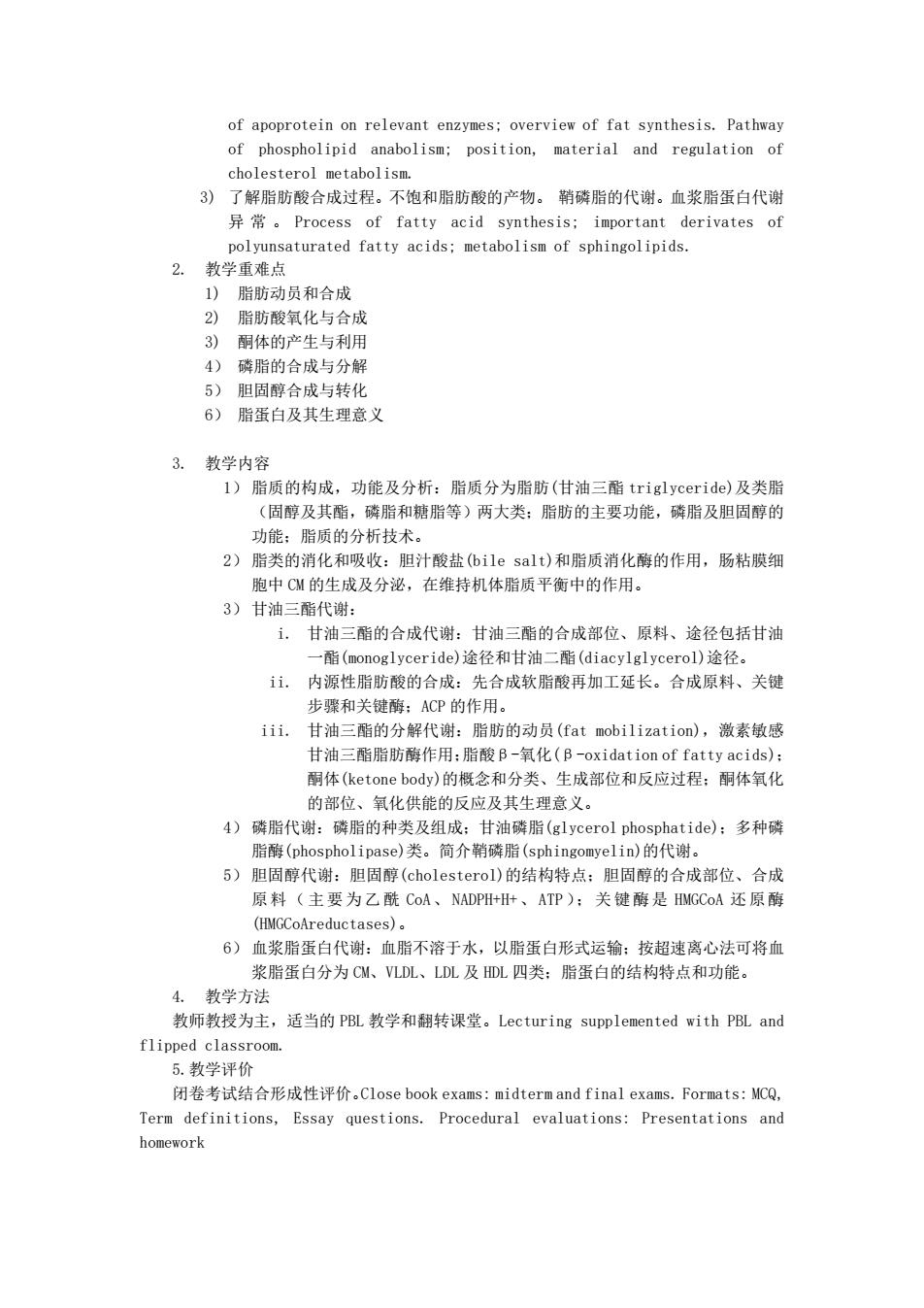
of apoprotein on relevant enzymes;overview of fat synthesis.Pathway of phospholipid anabolism;position,material and regulation of cholesterol metabolism. 3)了解脂肪酸合成过程。不饱和脂肪酸的产物。鞘磷脂的代谢。血浆脂蛋白代谢 异常。Process of fatty acid synthesis;important derivates of polyunsaturated fatty acids;metabolism of sphingolipids. 2.教学重难点 1)脂肪动员和合成 2)脂肪酸氧化与合成 3) 酮体的产生与利用 4) 磷脂的合成与分解 5) 胆固醇合成与转化 6)脂蛋白及其生理意义 3.教学内容 1)脂质的构成,功能及分析:脂质分为脂肪(甘油三酯triglyceride)及类脂 (固醇及其酯,磷脂和糖脂等)两大类:脂肪的主要功能,磷脂及胆固醇的 功能:脂质的分析技术。 2)脂类的消化和吸收:胆汁酸盐(bi1esal1t)和脂质消化酶的作用,肠粘膜细 胞中C的生成及分泌,在维持机体脂质平衡中的作用。 3)甘油三酯代谢: 1.甘油三酯的合成代谢:甘油三酯的合成部位、原料、途径包括甘油 一酯(monoglyceride)途径和甘油二酯(diacylglycerol)途径。 .内源性脂肪酸的合成:先合成软脂酸再加工延长。合成原料、关键 步骤和关键酶:ACP的作用。 iii.甘油三酯的分解代谢:脂肪的动员(fat mobilization),激素敏感 甘油三酯脂肪酶作用:脂酸B-氧化(B-oxidation of fatty acids): 酮体(ketone body)的概念和分类、生成部位和反应过程:酮体氧化 的部位、氧化供能的反应及其生理意义。 4)磷脂代谢:磷脂的种类及组成:甘油磷脂(glycerol phosphatide):多种磷 脂酶(phospholipase)类。简介鞘磷脂(sphingomyelin)的代谢。 5)胆固醇代谢:胆固醇(cholesterol)的结构特点:胆固醇的合成部位、合成 原料(主要为乙酰CoA、NADPH+H+、ATP):关键酶是HMGCoA还原酶 (HMGCoAreductases)o 6)血浆脂蛋白代谢:血脂不溶于水,以脂蛋白形式运输:按超速离心法可将血 浆脂蛋白分为CM、VLDL、LDL及HDL四类:脂蛋白的结构特点和功能。 4.教学方法 教师教授为主,适当的PBL教学和翻转课堂。Lecturing supplemented with PBL and flipped classroom. 5.教学评价 闭卷考试结合形成性评价。Close book exams:midterm and final exams..Formats:MCQ, Term definitions,Essay questions.Procedural evaluations:Presentations and homework
of apoprotein on relevant enzymes; overview of fat synthesis. Pathway of phospholipid anabolism; position, material and regulation of cholesterol metabolism. 3) 了解脂肪酸合成过程。不饱和脂肪酸的产物。 鞘磷脂的代谢。血浆脂蛋白代谢 异 常 。 Process of fatty acid synthesis; important derivates of polyunsaturated fatty acids; metabolism of sphingolipids. 2. 教学重难点 1) 脂肪动员和合成 2) 脂肪酸氧化与合成 3) 酮体的产生与利用 4) 磷脂的合成与分解 5) 胆固醇合成与转化 6) 脂蛋白及其生理意义 3. 教学内容 1) 脂质的构成,功能及分析:脂质分为脂肪(甘油三酯 triglyceride)及类脂 (固醇及其酯,磷脂和糖脂等)两大类;脂肪的主要功能,磷脂及胆固醇的 功能;脂质的分析技术。 2) 脂类的消化和吸收:胆汁酸盐(bile salt)和脂质消化酶的作用,肠粘膜细 胞中 CM 的生成及分泌,在维持机体脂质平衡中的作用。 3) 甘油三酯代谢: i. 甘油三酯的合成代谢:甘油三酯的合成部位、原料、途径包括甘油 一酯(monoglyceride)途径和甘油二酯(diacylglycerol)途径。 ii. 内源性脂肪酸的合成:先合成软脂酸再加工延长。合成原料、关键 步骤和关键酶;ACP 的作用。 iii. 甘油三酯的分解代谢:脂肪的动员(fat mobilization),激素敏感 甘油三酯脂肪酶作用;脂酸β-氧化(β-oxidation of fatty acids); 酮体(ketone body)的概念和分类、生成部位和反应过程;酮体氧化 的部位、氧化供能的反应及其生理意义。 4) 磷脂代谢:磷脂的种类及组成;甘油磷脂(glycerol phosphatide);多种磷 脂酶(phospholipase)类。简介鞘磷脂(sphingomyelin)的代谢。 5) 胆固醇代谢:胆固醇(cholesterol)的结构特点;胆固醇的合成部位、合成 原料( 主要为乙 酰 CoA、NADPH+H+、ATP);关键 酶是 HMGCoA 还原酶 (HMGCoAreductases)。 6) 血浆脂蛋白代谢:血脂不溶于水,以脂蛋白形式运输;按超速离心法可将血 浆脂蛋白分为 CM、VLDL、LDL 及 HDL 四类;脂蛋白的结构特点和功能。 4. 教学方法 教师教授为主,适当的 PBL 教学和翻转课堂。Lecturing supplemented with PBL and flipped classroom. 5.教学评价 闭卷考试结合形成性评价。Close book exams: midterm and final exams. Formats: MCQ, Term definitions, Essay questions. Procedural evaluations: Presentations and homework

第六章生物氧化Biological0 xidation 1.教学目标 1)掌握生物氧化的概念。呼吸链的概念、种类、组成和电子传递体的顺序。氧化 磷酸化的概念和偶联部位。解偶联剂。体内产生ATP的方式。其他高能磷酸化 Concept of biological oxidation;components of respiratory chain and their sequence;concept of coupled oxidative phosphorylation and coupling position uncoupler;two ways to ATP production in vivo:other high energy phosphate compounds; 2)熟悉氧化磷酸化的化学渗透假说和影响因素。NADH进入线粒体的两种穿梭机制。 chemiosmotic hypothesis of oxidative phosphorylation and influential factors;shuttle mechanisms for NADH to enter mitochondrial 3)了解其他氧化体系。Other oxidative systems.. 2.教学重难点 1)两条呼吸链的组成和顺序 2)化学渗透假说和氧化磷酸化 3.教学内容 1)生物氧化的概念及其与体外氧化的异同。 2)生成ATP的氧化体系:呼吸链respiratory chain(电子传递链electron transfer chain)的概念、组成和电子传递的顺序:氧化磷酸化(oxidative phosphorylation).的概念、偶联部位及偶联部位的确定:电子传递中质子的 跨膜转移和能量的产生:P/0比值:化学渗透假说(chemiosmotic hypothesis): ATP合酶(ATP synthase)。 3) 氧化磷酸化的影响因素(电子传递抑制剂inhibitor、解偶联剂uncoupler、 ADP、甲状腺素thyroxin等):体内产生ATP的方式包含氧化磷酸化和底物水 平磷酸化(substrate level phosphorylation):除ATP外,体内其他高能化 合物(energy--rich compound):NADH通过a-磷酸甘油穿梭(a- phosphoglycerol shuttle)和苹果酸-天冬氨酸穿梭(malate-aspartate shuttle)进入线粒体。 4)其他氧化与抗氧化体系:简介需氧脱氢酶(aerobic dehydrogenase)和氧化酶 (oxidation enzyme)、过氧化氢酶(hydrogen peroxidase)和过氧化物酶 (peroxydase)、超氧化物岐化酶(hepatocuprein)及微粒体(microsome).中的 酶类。 4.教学方法 教师教授为主,适当的PBL教学和翻转课堂。Lecturing supplemented with PBL and flipped classroom 5.教学评价 闭卷考试结合形成性评价。Close book exams:midterm and final exams.Formats:MCQ, Term definitions,Essay questions.Procedural evaluations:Presentations and homework 第七章氨基酸代谢Metabolism of Amino Acids
第六章 生物氧化 Biological Oxidation 1. 教学目标 1) 掌握生物氧化的概念。呼吸链的概念、种类、组成和电子传递体的顺序。氧化 磷酸化的概念和偶联部位。解偶联剂。体内产生 ATP 的方式。其他高能磷酸化 合物。Concept of biological oxidation; components of respiratory chain and their sequence; concept of coupled oxidative phosphorylation and coupling position ; uncoupler; two ways to ATP production in vivo; other high energy phosphate compounds; 2) 熟悉氧化磷酸化的化学渗透假说和影响因素。NADH 进入线粒体的两种穿梭机制。 chemiosmotic hypothesis of oxidative phosphorylation and influential factors; shuttle mechanisms for NADH to enter mitochondrial 3) 了解其他氧化体系。Other oxidative systems. 2. 教学重难点 1) 两条呼吸链的组成和顺序 2) 化学渗透假说和氧化磷酸化 3. 教学内容 1) 生物氧化的概念及其与体外氧化的异同。 2) 生成 ATP 的氧化体系:呼吸链 respiratory chain(电子传递链 electron transfer chain)的概念、组成和电子传递的顺序;氧化磷酸化(oxidative phosphorylation)的概念、偶联部位及偶联部位的确定;电子传递中质子的 跨膜转移和能量的产生;P/O 比值;化学渗透假说(chemiosmotic hypothesis); ATP 合酶(ATP synthase)。 3) 氧化磷酸化的影响因素(电子传递抑制剂 inhibitor、解偶联剂 uncoupler、 ADP、甲状腺素 thyroxin 等);体内产生 ATP 的方式包含氧化磷酸化和底物水 平磷酸化(substrate level phosphorylation);除 ATP 外,体内其他高能化 合 物 (energy-rich compound) ; NADH 通 过 α- 磷 酸 甘 油 穿 梭 (α- phosphoglycerol shuttle) 和 苹 果 酸 - 天 冬 氨 酸 穿 梭 (malate-aspartate shuttle)进入线粒体。 4) 其他氧化与抗氧化体系:简介需氧脱氢酶(aerobic dehydrogenase)和氧化酶 (oxidation enzyme)、过氧化氢酶(hydrogen peroxidase)和过氧化物酶 (peroxydase)、超氧化物岐化酶(hepatocuprein)及微粒体(microsome)中的 酶类。 4. 教学方法 教师教授为主,适当的 PBL 教学和翻转课堂。Lecturing supplemented with PBL and flipped classroom. 5.教学评价 闭卷考试结合形成性评价。Close book exams: midterm and final exams. Formats: MCQ, Term definitions, Essay questions. Procedural evaluations: Presentations and homework 第七章 氨基酸代谢 Metabolism of Amino Acids

1.教学目标 1)掌握蛋白质的营养价值。氨基酸的脱氨基作用:转氨作用,L-谷氨酸氧化脱氨, 嘌呤核苷酸循环。氨的代谢:氨的来源,丙氨酸和谷氨酰胺对氨的转运,尿素 的生成(主要器官、反应步骤、调节)。几种氨基酸的脱羧产物:组胺、Y-氨 基丁酸、5一羟色胺等。一碳单位的概念、种类、来源及生理作用。甲硫氨酸循 nutritional value of protein,deaminization of amino acids: transamination,L-glutamate oxidative deamination,purine nucleotide cycle.metabolism of ammonia:source of ammonia,transportation of ammonia by alanine and glutamine,generation of ureal (chief organ,steps of reaction,regulation).decarboxylation products of several amino acids:histamine,Y-aminobutyric acid,5-HTA.concept,types,source and physiological functions of one carbon unit. 2)熟悉几种蛋白水解酶的作用特点。ā-酮酸的代谢。含硫氨基酸、芳香族氨基酸 和支链氨基酸的代谢。effective features of several proteinase, metabolism of a-keto acid,metabolism of sulfur amino acid,aromatic amino acid and branched-chain amino acid. 3)了解体内蛋白质的转换更新。蛋白质的消化、吸收及腐败作用。transform and refreshment of protein in vivo,digestion,absorption and rancidification of protein. 2.教学重难点 1)联合脱氨 2)尿素循环 3)甲硫氨酸循环 3.教学内容 l)蛋白质的营养价值:蛋白质的需要量和营养价值(nutritive value):营养必需 氨基酸(essential amino acid)的概念. 2)蛋白质的消化、吸收和腐败(digestion,absorption and rancidification): 氨基酸吸收载体的作用:蛋白质在肠道中的腐败作用。 3)氨基酸的一般代谢(general metabolism):简介体内蛋白质的转换更新。氨基 酸的脱氨基作用(deamination):转氨作用(transamination)的概念,转氨酶 (transaminase)和磷酸吡哆醛(pyridoxal phosphate)的作用:L-谷氨酸氧化脱 氨(oxidative deamination)的反应及特点;嘌呤核苷酸循环(purine nucleotide cycle)的途径。a-酮酸(a-keto acid)的代谢:生糖、生酮及生 糖兼生酮氨基酸(glucogenic amino acid,ketogenic amino acid,glucogenic and ketogenic amino acid)的代谢及它们与三羧酸循环(TCA cycle)的联系。 4)氨的代谢:体内氨的来源:丙氨酸和谷氨酰胺对氨的转运:尿素的生成(鸟氨 酸循环ornithine cycle)的主要器官、详细步骤、生理意义、调节:高血氨 症和氨中毒(high toxic blood ammonia and ammonia intoxication)。 5)个别氨基酸的代谢:几种氨基酸的脱羧产物(Y-氨基丁酸Y-propalanine、. taurochorate、多胺polyamine)及生理功能。一碳单位(one carbon unit)的 概念、分类、与FH4的关系、来源及生理功能。 4.教学方法
1. 教学目标 1) 掌握蛋白质的营养价值。氨基酸的脱氨基作用:转氨作用,L-谷氨酸氧化脱氨, 嘌呤核苷酸循环。氨的代谢:氨的来源,丙氨酸和谷氨酰胺对氨的转运,尿素 的生成(主要器官、反应步骤、调节)。几种氨基酸的脱羧产物:组胺、γ-氨 基丁酸、5-羟色胺等。一碳单位的概念、种类、来源及生理作用。甲硫氨酸循 环 。 nutritional value of protein, deaminization of amino acids: transamination, L-glutamate oxidative deamination, purine nucleotide cycle. metabolism of ammonia: source of ammonia, transportation of ammonia by alanine and glutamine, generation of ureal (chief organ, steps of reaction, regulation). decarboxylation products of several amino acids: histamine, γ-aminobutyric acid, 5-HTA. concept, types, source and physiological functions of one carbon unit. 2) 熟悉几种蛋白水解酶的作用特点。α-酮酸的代谢。含硫氨基酸、芳香族氨基酸 和 支 链 氨 基 酸 的 代 谢 。 effective features of several proteinase, metabolism of α-keto acid, metabolism of sulfur amino acid, aromatic amino acid and branched-chain amino acid. 3) 了解体内蛋白质的转换更新。蛋白质的消化、吸收及腐败作用。transform and refreshment of protein in vivo, digestion, absorption and rancidification of protein. 2. 教学重难点 1) 联合脱氨 2) 尿素循环 3) 甲硫氨酸循环 3. 教学内容 1) 蛋白质的营养价值:蛋白质的需要量和营养价值(nutritive value);营养必需 氨基酸(essential amino acid)的概念。 2) 蛋白质的消化、吸收和腐败(digestion, absorption and rancidification): 氨基酸吸收载体的作用;蛋白质在肠道中的腐败作用。 3) 氨基酸的一般代谢(general metabolism):简介体内蛋白质的转换更新。氨基 酸的脱氨基作用(deamination):转氨作用(transamination)的概念,转氨酶 (transaminase)和磷酸吡哆醛(pyridoxal phosphate)的作用;L-谷氨酸氧化脱 氨 (oxidative deamination) 的 反 应 及 特 点 ; 嘌 呤 核 苷 酸 循 环 (purine nucleotide cycle)的途径。α-酮酸(α-keto acid)的代谢:生糖、生酮及生 糖兼生酮氨基酸(glucogenic amino acid, ketogenic amino acid, glucogenic and ketogenic amino acid) 的代谢及它们与三羧酸循环(TCA cycle)的联系。 4) 氨的代谢:体内氨的来源;丙氨酸和谷氨酰胺对氨的转运;尿素的生成(鸟氨 酸循环 ornithine cycle)的主要器官、详细步骤、生理意义、调节;高血氨 症和氨中毒(high toxic blood ammonia and ammonia intoxication)。 5) 个别氨基酸的代谢:几种氨基酸的脱羧产物(γ-氨基丁酸γ- propalanine、 taurochorate、多胺 polyamine)及生理功能。一碳单位(one carbon unit) 的 概念、分类、与 FH4 的关系、来源及生理功能。 4. 教学方法